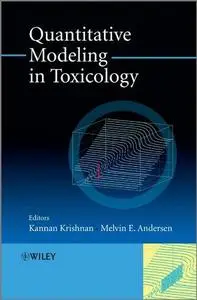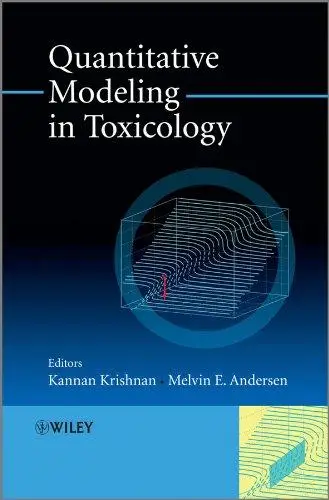Quantitative Modeling in Toxicology By
2010 | 484 Pages | ISBN: 0470998091 | PDF | 21 MB
2010 | 484 Pages | ISBN: 0470998091 | PDF | 21 MB
Governments around the world are passing laws requiring industry to assess the toxicity of the chemicals and products they produce, but to do so while reducing, refining, or even replacing testing on animals. To meet these requirements, experimental toxicologists and risk assessors are adopting quantitative approaches and computer simulations to study the biological fate and effects of chemicals and drugs. In Quantitative Modeling in Toxicology leading experts outline the current state of knowledge on the modeling of dose, tissue interactions and tissue responses. Each chapter describes the mathematical foundation, parameter estimation, challenges and perspectives for development, along with the presentation of a modeling template. Additionally, tools and approaches for conducting uncertainty, sensitivity and variability analyses in these models are described. Topics covered include: the quantitative models of pharmacokinetics of individual chemicals and mixtures models for toxicant-target tissue interaction. models for cellular, organ, and organism responses. approaches, tools and challenges for model application and evaluation A website containing computer codes accompanies the book to help the reader reconstruct the models described and discussed in the various chapters. Quantitative Modeling in Toxicology serves as an essential reference source and tool box for risk assessors and researchers and students in toxicology, public health, pharmacology, and human toxicology interested in developing quantitative models for a better understanding of dose-response relationships.Content: Chapter 1 Quantitative Modeling in Toxicology: An Introduction (pages 1–18): Dr Melvin E. Andersen and Dr. Kannan KrishnanChapter 2 PBPK Modeling: A Primer (pages 19–58): Dr. Kannan Krishnan, George D. Loizou, Martin Spendiff, John C. Lipscomb and Dr Melvin E. AndersenChapter 3 Pharmacokinetic Modeling of Manganese – An Essential Element (pages 59–82): Andy Nong, Michael D. Taylor, Miyoung Yoon and Dr Melvin E. AndersenChapter 4 Physiologically Based Modeling of Pharmacokinetic Interactions in Chemical Mixtures (pages 83–105): Sami Haddad, Robert Tardif, Jonathan Boyd and Kannan KrishnanChapter 5 Physiological Parameters and Databases for PBPK Modeling (pages 107–134): Douglas O. Johns, Elizabeth Oesterling Owens, Chad M. Thompson, Babasaheb Sonawane, Dale Hattis and Dr. Kannan KrishnanChapter 6 Modeling Cholinesterase Inhibition (pages 135–165): Charles Timchalk, Paul M. Hinderliter and Torka S. PoetChapter 7 Modeling of Protein Induction and Dose?Dependent Hepatic Sequestration (pages 167–179): Andy Nong and Dr Melvin E. AndersenChapter 8 Bistable Signaling Motifs and Cell Fate Decisions (pages 181–198): Sudin Bhattacharya, Qiang Zhang and Dr Melvin E. AndersenChapter 9 Ultrasensitive Response Motifs in Biochemical Networks (pages 199–217): Qiang Zhang, Sudin Bhattacharya, Courtney G. Woods and Dr Melvin E. AndersenChapter 10 Gene and Protein Expression – Modeling Nested Motifs in Cellular and Tissue Response Networks (pages 219–233): Dr Melvin E. Andersen, Qiang Zhang and Sudin BhattacharyaChapter 11 Modeling Liver and Kidney Cytotoxicity (pages 235–250): Kai H. Liao, Yei M. Tan, Harvey J. Clewell and Dr Melvin E. AndersenChapter 12 Computational Model for Iodide Economy and the HPT Axis in the Adult Rat (pages 251–267): Jeffrey W. Fisher and Eva D. McLanahanChapter 13 Two?Stage Clonal Growth Modeling of Cancer (pages 269–282): Rory B. Conolly and Dr Melvin E. AndersenChapter 14 Statistical and Physiological Modeling of the Toxicity of Chemicals in Mixtures (pages 283–297): Hisham A. El?Masri, Michael A. Lyons and Raymond S. H. YangChapter 15 (Q)SAR Models of Adverse Responses: Acute Systemic Toxicity (pages 299–314): Mark T. D. Cronin, Yana K. Koleva and Judith C. MaddenChapter 16 Modeling Exposures to Chemicals from Multiple Sources and Routes (pages 315–351): Panos G. Georgopoulos, Sastry S. Isukapalli and Dr. Kannan KrishnanChapter 17 Probabilistic Reverse Dosimetry Modeling for Interpreting Biomonitoring Data (pages 353–369): Yu?Mei Tan and Harvey J. ClewellChapter 18 Quantitative Modeling in Noncancer Risk Assessment (pages 371–398): Q. Jay Zhao, Lynne Haber, Melissa Kohrman?Vincent, Patricia Nance and Michael DoursonChapter 19 Application of Physiologically Based Pharmacokinetic Modeling in Health Risk Assessment (pages 399–428): Harvey J. ClewellChapter 20 Uncertainty, Variability, and Sensitivity Analyses in Simulation Models (pages 429–458): Sastry S. Isukapalli, Martin Spendiff, Panos G. Georgopoulos and Dr. Kannan KrishnanChapter 21 Evaluation of Quantitative Models in Toxicology: Progress and Challenges (pages 459–475): Dr. Kannan Krishnan and Dr Melvin E. Andersen



